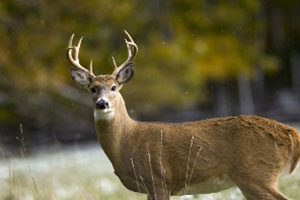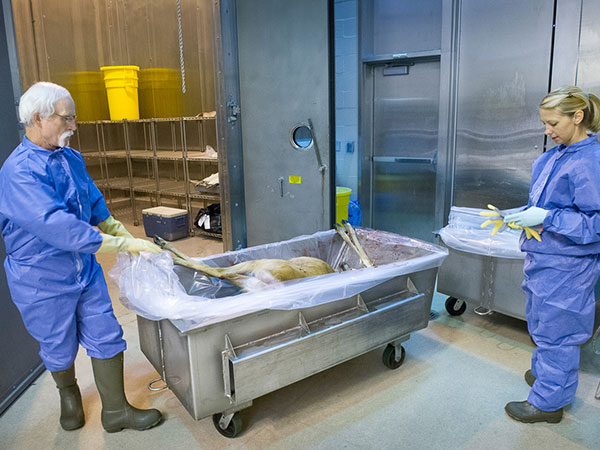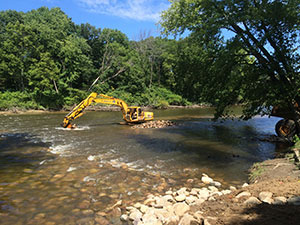- Details
(Provided by MDNR)
A 1.5-year-old buck taken Wednesday, Nov. 16, in Clinton Countyís Eagle Township is likely the ninth free-ranging deer in Michigan to test positive for chronic wasting disease (CWD).
A hunter took the animal within an area where deer check is mandatory and brought the deer to a Department of Natural Resources check station. Preliminary tests conducted by the DNR came back positive for CWD. The animal currently is being tested by the U.S. Department of Agriculture's National Veterinary Services Laboratory in Ames, Iowa, to finalize confirmation of the disease. Confirmation will take a couple weeks.
The DNR reminds hunters that bringing harvested deer to a DNR check station is critical to helping the state understand the extent of CWD in Michigan.
"This latest suspect deer reinforces how critical hunters are in battling this disease," said Chad Fedewa, DNR wildlife biologist. "We are counting on hunters to bring their deer in for testing so we have a better understanding about disease distribution. If this hunter had not followed the law, we would have no idea that the disease has traveled farther west."
- Details
(Provided by MDNR)
 Hunting Continues to Drive Economic Impact in MichiganHunting remains a vibrant annual tradition in Michigan, with generations across the state and beyond preparing for Opening Day on Tuesday, November 15. Along with that rich heritage comes a significant impact on Michigan's economy.
Hunting Continues to Drive Economic Impact in MichiganHunting remains a vibrant annual tradition in Michigan, with generations across the state and beyond preparing for Opening Day on Tuesday, November 15. Along with that rich heritage comes a significant impact on Michigan's economy.
This year, more than 525,000 hunters are expected to participate in the annual firearms season for deer which accounts for the largest economic impact of hunting in the state. The DNR estimates more than 90 percent of Michigan hunters will pursue deer this year, with hunters spending an average of 7 days afield during the firearm season. In Michigan, 60 percent of hunters hunt only deer making the upcoming firearm season especially critical for the economy.
The U.S. Fish and Wildlife Service estimates hunting in Michigan generates more than $2.3 billion in economic impact in the state, including expenses related to food and lodging and $1.3 billion spent on equipment.
"Hunting provides the perfect opportunity to get out and experience Michigan's vast natural resources while contributing to the tremendous quality of life found here in our state," said Michigan Economic Development Corporation CEO Steve Arwood. "We know hunting drives travel to Michigan as well as within the state, and that travel in turn generates economic impact for communities and businesses across Michigan."
In addition to the overall economic impact of hunting provided by the U.S. Fish and Wildlife Service, in 2015 leisure travel spending on hunting reached an estimated $123.8 million, up from $85 million in 2014, according to data from D.K. Shifflet. Hunting and fishing leisure travel spending came in at a combined $340 million in 2015.
- Details
(Provided by MDNR)
 DNR Disease Laboratory workers prep a deer for testing.
DNR Disease Laboratory workers prep a deer for testing.
DNR Disease Laboratory workers prep a deer for testing.
The discovery of an eighth free-ranging Michigan white-tailed deer with chronic wasting disease this summer was a disappointment to Michigan DNR wildlife officials.
However, DNR deer and elk specialist Chad Stewart said there was a little bit of good news associated with that discovery.
DNA testing showed that the latest infected deer was related to four of the other previously identified infected deer," Stewart said. "So far, all eight have been related to each other somehow, most very closely.
"The overall numbers are still very low, so we're optimistic we can have some success in keeping this disease confined to a relatively small geographic area."
Michigan's first brush with CWD - an always fatal neurological disorder that infects members of the deer family - occurred in 2008 when an infected 3-year-old doe was discovered in a captive deer facility in the southwestern Lower Peninsula.
That facility was depopulated and none of those deer tested positive for the disease.
- Details
(Provided by MDNR)
Conservation officers with the Michigan DNR urge deer hunters to engage in an ethical hunt: Buy a license before going out and don't loan kill tags.
Every deer hunting season, DNR conservation officers encounter people engaged in unethical hunting practices. These officers tackle many cases of hunters buying hunting licenses after harvesting deer or loaning kill tags to friends or relatives.
"Each year, we see cases of individuals waiting to buy licenses until after they have shot a deer," said Dean Molnar, assistant chief of the DNR's Law Enforcement Division. "We remind all hunters that you must buy your license before you go out to hunt and have it in your possession when afield. Buying a license is not only the ethical and responsible thing to do, it is the law. Harvesting a deer without a license is poaching."
- Details
(Provided by MDNR)
 Kalamazoo River Project Targets Spawning SturgeonRecently an excavator was moving rock out into the middle of the Kalamazoo River in southwest Michigan. An interested angler stopped to ask the crew what was going on.
Kalamazoo River Project Targets Spawning SturgeonRecently an excavator was moving rock out into the middle of the Kalamazoo River in southwest Michigan. An interested angler stopped to ask the crew what was going on.
"I told him we're building a spawning riffle for lake sturgeon," said Jay Wesley, Lake Michigan Basin Coordinator for the DNR. "That's a place where adult lake sturgeon can deposit their eggs. The eggs fall into the crevices of the rock and protect them against predators and turbulent flows."
The Kalamazoo River sturgeon riffle is approximately 26 miles upstream from Lake Michigan and 800 feet downstream of Allegan Dam. It is made of 4- to 24-inch field stone that is placed across the river. The overall size of the riffle is 22,400 square feet - about half the size of a football field.
The project was made possible by a $200,000 contribution from Consumers Energy and a $190,000 Great Lakes Tribal Coastal Grant provided to the Match-E-Be-Nash-She-Wish Band of Pottawatomi Indians (also known as the Gun Lake Tribe). The project features numerous partners; including the DNR's Parks and Recreation Division and Allegan Heavy Equipment Crew, Stantec (provided design) and Grand Valley State University (providing monitoring).


